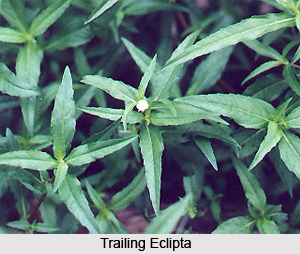 Trailing Eclipta is a tiny, upright or prostate, many-branched and a roughly haired yearly herb. It grows upto 30 cm in height. It has a circular, weak stem, plain ecliptic and hairy leaves, uneven in shape, bright dark green in colour with extremely tiny flowers, called florets. Its small, black seeds look a lot like mustard seeds. Trailing eclipta is native to India and grows as an ordinary weed.
Trailing Eclipta is a tiny, upright or prostate, many-branched and a roughly haired yearly herb. It grows upto 30 cm in height. It has a circular, weak stem, plain ecliptic and hairy leaves, uneven in shape, bright dark green in colour with extremely tiny flowers, called florets. Its small, black seeds look a lot like mustard seeds. Trailing eclipta is native to India and grows as an ordinary weed.
The herb contains alkaloid ecliptine. It also contains the alkaloid nicotene and resin. The leaves have more of water and soft cellulose content.
Methods of usage
Trailing Eclipta mends chronic disorders like liver enlargement, fever, catarrh, uterine haemorrhage, skin abnormality, acting also as revitalisers for immature greying.
Healing Power and Medicinal Properties of trailing eclipta
The fresh plant, leaves and roots are all used for remedial purposes. The refreshing plant and the leaves are revitalisers. They rectify the perturbed processes of nutrition and restitutes the normal function of the system. They also alleviate secretion or excretion by opening the natural pathway and pores of the body, like that of the skin. The roots and leaves of the plant also encourage the flow of bile. The leaves have a somewhat biting and acrid taste. It is better not to consume the leaves alone, but to blend them with other tasteless leaves or some other medium.
Liver and Spleen Disorders cured by trailing eclipta
Trailing eclipta is useful in the enlargement of liver and spleen. It is also helpful in other liver troubles. A decoction of the herb is taken in dosages of 1 teaspoon twice daily. The leaves of the plant can also be used for disorders like jaundice. One teaspoon of the juice can be combined with an aromatic, like cardamom and cinnamon. For catarrhal jaundice accompanied with release of mucus from the mucous membranes of the intestine, a large pill of fresh leaves, mixed with a few mashed peppercorns must be had with curd early in the morning, for almost a week.
Fevers cured by trailing eclipta
The drug has the dimension to alleviate feverishness and induce a feeling of coolness. The fresh juice of the plant should be taken in dosages of 2 to 8 ml. The juice of the leaves in amalgamation with cardamom and cinnamon can be consumed in fevers, in dosages of 1 teaspoon.
Catarrh in Babies healed by trailing eclipta
The juice of the plant is handy for newborns suffering from catarrh. Two drops of the juice mixed with honey is given in such cases. The juice of the leaves can also be used for this purpose in doses of 2 drops mixed with 8 drops of honey.
Uterine Haemorrhages trailing eclipta
The leaves of the plant are useful in uterine haemorrhages or bleeding. An extraction of the leaves can be consumed dosages of 60 to 120 ml, twice daily.
Skin Disorders healed by trailing eclipta
Trailing eclipta is good for glandular inflammations, elephantiasis and other skin diseases. A paste of the herb amalgamated with sesame (tit) oil is administered externally over the affected parts. A paste of the leaves is also administered to acute glandular inflammations, skin diseases and to wounds as a styptic or astringent. The juice of the leaves can be used constructively for cleansing and healing sores.
Premature Greying of Hair cured by trailing eclipta
For premature greying of hair, two parts of the herb- one part of black sesame seeds and one part of Indian gooseberry (amla) are evenly fine-grained. One teaspoon of this grind is had with milk and sugar twice everyday for mending this trouble.
Other Uses of trailing eclipta
Hair Growth - The refreshing juice of the leaves is useful in boosting hair growth. The juice should be rubbed into the scalp for this intention.



















